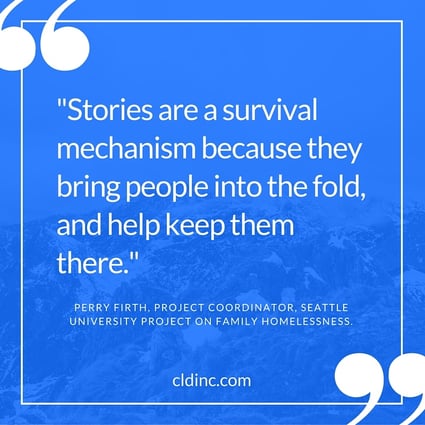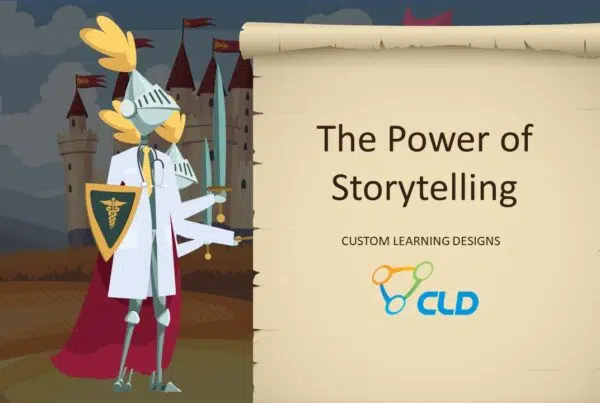
Stories are central to the human experience, and have been for as long as history has been recorded. In fact, recorded history is narratives, that clue us in on human nature, bring new perspectives to us, and generally engage us more thoroughly in the world in which we live. Stories come naturally, as you can see when children play make-believe. And they can and should be a pillar of outstanding teaching and training.
Basic Skills Required to Create the Right Story Framework
Not just any story will engage your training audience, though you do have broad scope for storytelling. It’s important that you know your audience and choose stories that make sense for them. In training scenarios, you must also review your stories beforehand for information that could make people uncomfortable. For example, if you tell a story about a colleague who made a major blunder, even if you don’t name names, it can be obvious who it’s about, and if that person has friends in training, you risk alienating them. Of course, you have to forget about stories that make light of cultures or beliefs, even accidentally.
The best stories do several things:
- They build tension, so the audience wonders what happens next.
- They include sensory details that help learners insert themselves into the story.
- They highlight moral behavior by allowing learners to mentally “try on” different decisions.
- If they feature people on the margins of society, they should humanize them.
- They should include action steps relevant to the listeners.
- Ideally they should involve the overcoming of some adversity.
- They should be told before fact-sharing to prime people for action.
- They should illuminate big issues with individual experiences rather than just statistics.
How Great Storytelling Affects the Brain
Excellent storytelling actually changes the brain as it captures attention. In fact, if you think back to technical conferences or presentations you’ve attended, it is likely that the stories have remained with you after you’ve forgotten the numbers and graphs. When people are drawn into a story, their brains release a neurochemical called oxytocin, which promotes human bonding by indicating “It’s safe to approach this person.” Oxytocin is produced when we are shown kindness or feel trusted, and it prompts empathy and cooperation.
Additionally, a part of the brain called the amygdala, which regulates emotions, has the ability to override the logic of the pre-frontal cortex. What that means is if new skills can be “passed through” the amygdala, they’re more likely to be remembered and used. In other words, training should have an emotional component. At the very least, it should answer the question of why the audience is learning something new. While many anecdotes, bullet points, and facts only reside in the temporary “working” memory, the things people genuinely care about are processed into long term memory, where they can prompt real and sustained changes in attitudes and behaviors.
Striking the Right Balance Between Entertaining and Instructing
You might remember many years ago when the portmanteau “infotainment” was coined as a disparaging term, primarily applied to stories in the news media that were considered “fluff.” While there is some truth to it, balancing entertainment and learning through the strategic use of storytelling sets the stage for real learning that people actually use on the job. Stories are more than just a distraction from material (which, let’s face it, can be mundane). Rather, they are highly effective at teaching, and if an element of entertainment is what it takes for learning to “stick,” then it’s well worthwhile.
A study of museums and other cultural institutions recently produced two key takeaways, and they’re highly relevant to the sales trainer:
- Entertainment drives satisfaction and encourages “coming back” to the topic at hand.
- When people actually learn new things, it internally “justifies” the entertainment value of what is presented.
It doesn’t take much of a stretch of the imagination to understand how these concepts apply to training.
Storytelling for Different Training Program Objectives
Narratives can have different purposes depending on where in the training program they’re used. When a training course commences, a story can set the tone for the course and create rapport between trainer and trainees. It can also create the sense of being in a comfortable and safe environment (due to release of oxytocin prompted by the sharing of stories).
During the “meat” of a course, stories help learners make connections between old knowledge and new concepts, and they can help create connections between multiple complex ideas. Furthermore, they can retain learners’ attention, which is essential to the incorporation and retention of new information. Stories shared at the conclusion of a training course can also assist with the retention of new information, and can tie it all together in a way that illustrates what has been learned in a narrative that’s relevant to the learners.
Narratives have the power to influence, teach, and even save lives, as Scheherazade illustrated in “One Thousand and One Nights.” While your goals as a sales trainer may not directly be life-or-death scenarios, the ability of your trainees to carry out their work successfully actually does make a difference in the lives of patients, so don’t discount the importance of the stories you tell your learners. Stories speak not only to the higher brain centers, but to the emotions, and by doing so they can make an impact that dry facts simply cannot. We invite you to explore our blog, where you can learn more about the power of the narrative, and other ways pharmaceutical sales trainers help their learners get real results in the field.





